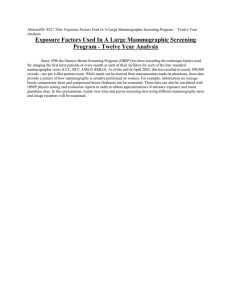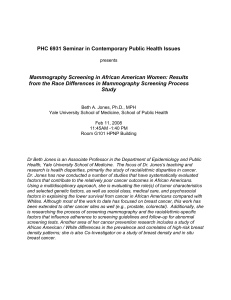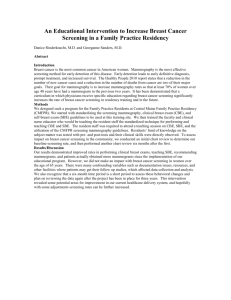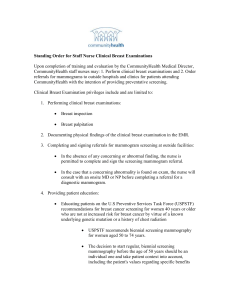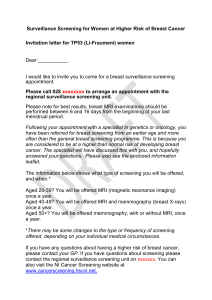In the name of god
advertisement
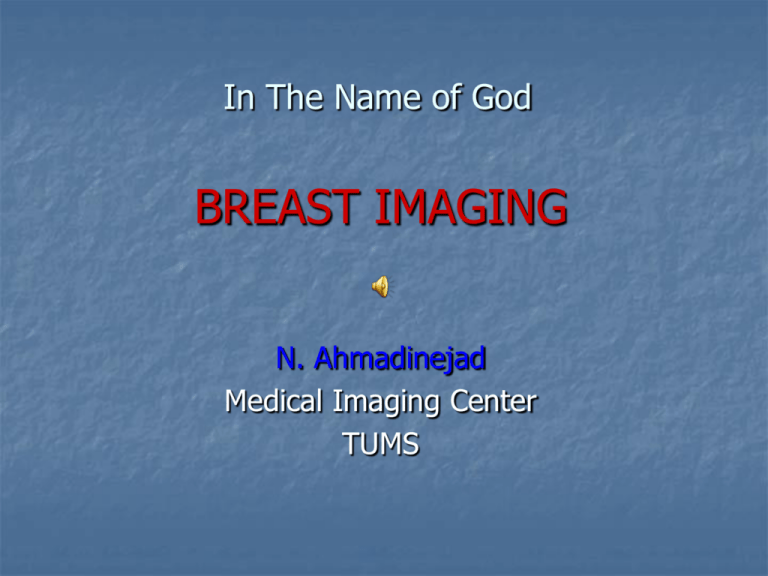
In The Name of God BREAST IMAGING N. Ahmadinejad Medical Imaging Center TUMS BREAST IMAGING Screening Diagnostic Mammography An excellent detection technique Mammography is early detection Not prevention The goal of screening for breast cancer is not to detect all breast abnormalities; the goal is to prevent deaths from breast cancer WHO Principles of Screening Disease is serious and prevalent; Test is sensitive, specific, well tolerated, cheap, changes therapy or outcome Minimal Carcinomas All invasive carcinomas measuring less than 1cm. All in situ carcinoma Lead time for mammographic detection range from2 to 4 or more years before a lesion becomes clinically evident Screening Guidelines ACS Women at average risk: Ages 20 to 39 ○ Age 40 and over ○ clinical breast examination at least every three years annual screening mammography and clinical breast exam Breast self-exam (BSE) is an option for women starting in their 20s Elderly women ○ 3/18/2016 continue screening as long as woman is in reasonably good health and would be a candidate for cancer treatment 10 BC Screening Interval US: American Cancer Society, American Medical Association: annual screening by the age of 40 Y National cancer institute: every 1-2 Y Biennale screening in Canada, Australia and much Europe Sweden: 18 mo. 40-49 and 24 mo. grater than 50 UK: every 3 Y Screening Guidelines ACS High Risk Patients Known BRCA1 or BRCA2 mutation First degree relative with BRCA1 or 2 and no testing themselves Radiation therapy to the chest between the ages of 10 and 30 yrs Have Li-Fraumeni, Cowden, or hereditary diffuse gastric syndromes, or a first degree relative with one of these syndromes Risk assessment tools> 20% lifetime 3/18/2016 12 Women who have a mother or sister with premenopausal BC being screening 5-10 Y earlier than the age at which the immediate relative was diagnosed Mammography: Pros *7 randomized trials demonstrate that there is a relative risk reduction in BCM by 20-30%, depending on age *Smaller cancers are less likely to metastasize, thus prognosis for a small tumor is better *Smaller cancers are amenable to breast conservation, and more cosmetic outcome than if tumors are larger It is not diagnostic unless The lesion has the typical characteristics of a malignant or benign mass spiculated MAMMOGRAPHIC PROJECTION STANDARD VIEWS Medio Lateral Obliqe (M.L.O) CranioCaudal(cc) ADDITIONAL VIEW 90-Degree lateral Spot Compression Magnification Exaggerated Cranio Caudal Cleavage Axilary Tail Tangenital Roll Techniqual aspect Positioning Evaluation Interpretation Digital Mammography Improved breast cancer detection over analog (film-screen) mammography for: Women with dense breasts Women under 50 Premenopausal women Lower radiation dose No increase in false positive rate Expensive
